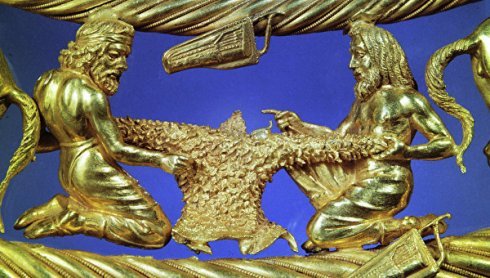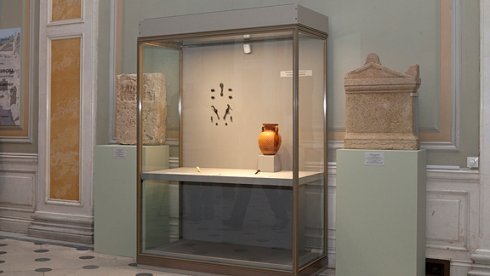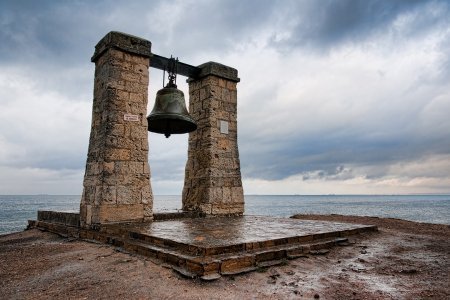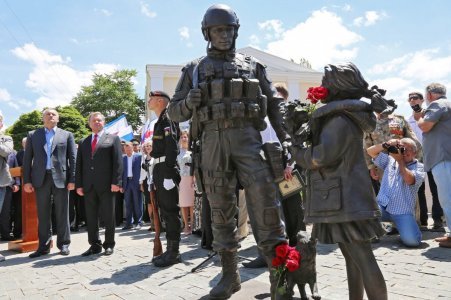By Olga Efimova
Start reading here
Crimean Scythian gold
Today, among all the Crimean cultural values, Ukraine is more likely to return the “Scythian gold” – a collection of Crimean values of the Scythian period that was transported as part of the Ukrainian exposition at the exhibition “Crimea: the gold and secrets of the Black Sea” to German and the Netherlands. The Crimean part of the collection includes about 500 exhibits (mainly ceramic and wood items), which are estimated at 1.5 million euros.

In August 2014, when the exhibition was over, the Allard Pierson Museum, where the exhibition was held, returned the Kiev exhibits in Ukraine, but as for the Crimean part of the collection, it started the negotiations with two countries – Russia and Ukraine. Russia insisted that the Crimean exhibits should be brought back to the museum, where they were taken for the exhibition.
Ukraine defended the position that the Crimean exhibits have been included in its museum fund and were the property of the Ukrainian state. While being far from the politics, the Allard Pierson Museum decided to take the case to court.
In November 2014, four Crimean museums that previously housed exhibits from the exhibition collection filed a lawsuit against the Allard Pierson Museum with a demand to return their “Scythian gold”. Crimean museum workers and Russian lawyers are appealing to the fact that the contracts were signed on behalf of the museum, so the exhibits should be returned to them. However, they admit that the contracts didn’t contain separate clauses regarding the return of the collection. “It was the standard contract. There was no separate clause regarding the return, but the document allows this return de rigore juris,” the director of the Central Museum of Tauris Andrey Malgin said.
In April 2015, the Amsterdam District Court declared Ukraine the party to a conflict, because “Ukraine considers itself the owner of these items and, therefore, has interests in these circumstances”. At the same time, the Adviser to the President of Russia on Culture Vladimir Tolstoy believes that the litigation can take years, as a legitimate court decision does not exist.
“This is a very lengthy issue, and it can last for years. Of course, it depends on the general political situation as well, because no direct legitimate judgment can be delivered,” Tolstoy said.
The court session is scheduled in Amsterdam on October 5, 2016. Meanwhile, in June 2016, the Kyiv’s Pechersk District court decided to arrest the Crimean collection of Scythian gold, which is in the Netherlands.
“Museum exhibits are the property of the Ukrainian state,” the court decision says. According to the General Procurator’s Office, if the Netherlands ignores this decision of the Ukrainian court or Kiev receives a negative response, Ukraine has every right to go to the international arbitration court and seek compensation.
Export of cultural property from Crimea
A few days after the formalization of the annexation of the Crimea, on March 29, 2014, the people’s deputy of Ukraine Vladimir Aryev said at the Verkhovna Rada session that cultural property items were exported from Crimea. According to him, paintings by Aivazovsky from Feodosia and exhibits from the Chersonese reserve were among the first exported items. The Crimean ‘authorities’ and the museum staff hurried to deny this information.
On October 21, 2015, the head of the Permanent Delegation of the Verkhovna Rada of Ukraine to the Parliamentary Assembly of the Black Sea Economic Cooperation (PABSEC) Lyudmila Denisova said that the exhibits from the Crimean museums – the Chersonese, Sudak museums and the Central Museum of Tavrida in Simferopol – are exported to the Russian Hermitage Museum (St. Petersburg).
The Hermitage press service denied this information. “It is not the first time when they announce this fact. We don’t know where they got that idea, but such information attacks occurred regularly every two months. We don’t export anything from Crimea,” the Hermitage representatives explained. However, there was the exhibition “In the Land of the Gryphon. Hermitage’s Antique Archaeology in Crimea”, where the items from the collection of the East Crimean historical and cultural reserve in Kerch have been presented, held in the Hermitage museum from October 24, 2015 to January 24, 2016.
In June 2016, the exhibition dedicated to the 200th anniversary of Ivan Aivazovsky, where the artist’s works have been sent from Crimea, was opened in the Tretyakov Gallery in Moscow. The ‘Minister’ of Culture of Crimea Arina Novoselskaya reported that 38 paintings by Aivazovsky were taken for the exhibition in Moscow on July 11. Then the exhibition will continue in St. Petersburg.

At the same time, the director of the Feodosia gallery believes that there is no reason to worry about the safety of paintings. “We give the paintings to the famous museum – the Tretyakov Gallery, but not for some private collection. There will be other valuable and rare exhibits, so the exhibition is protected at a high level. In addition, there is a special transfer and acceptance procedure for paintings. The Aivazovsky gallery experts will check the compliance of the originals after this event,” Tatyana Gayduk said.
However, people on the mainland Ukraine do not share the optimism of the Crimeans.
“Anything can happen to paintings by Aivazovsky. They can be stolen under the guise of restoration for many years or under other pretexts,” the expert of the Maidan of Foreign Affairs foundation Andrey Klimenko assumes.
“Paintings from the Aivazovsky gallery in Feodosiya are the part of the state museum fund of Ukraine. The Ministry of Culture as the central body of executive authorities must give permission for exporting of such items. Accordingly, everything that is carried out without this permission is illegal,” the head of museum and cultural values department at the Ministry of Culture of Ukraine Vasiliy Rozhko summed up.
Ukraine’s reaction
Besides statements of relevant departments and politicians on the unacceptability to export cultural heritage items from Crimea, there are practically no other steps taken by the state.
In particular, on October 3, 2015, the Ministry of Culture issued a statement in response to the transfer of the Museum-Reserve “Tauric Chersonese” into federal ownership having expressed deep outrage over the Russia’s actions. The Ministry of Culture recalled that “the Ancient City of Tauric Chersonese and its Chora” (5 century BC -14 century AD) located in the National Reserve “Tauric Chersonese” was included in the UNESCO World Heritage Site on behalf of Ukraine in 2013. In addition, the Ministry of Culture emphasized that all objects located on the territory of the AR Crimea were objects of cultural heritage of Ukraine.
On October 5, 2015, the Foreign Ministry of Ukraine commented the situation with the Chersonese and called UNESCO not to recognize any changes occurring in the territory of Crimea and Sevastopol in accordance with the UN resolution of 27 March 2014, which requires preserving the territorial integrity of Ukraine.

Museum-Reserve “Tauric Chersonese” (Sevastopol)
In October 2015, in response to giving 220 Crimean monuments the federal status, the Ministry of Culture of Ukraine also issued a statement calling these Russia’s actions illegal.
“The decision of the Russian Federation to include the Crimean cultural heritage monuments and their territories in the Unified State Register of cultural heritage of Russia is illegal,” the press service of the Ministry of Culture informed.
In its turn, the Prosecutor’s Office of Crimea opened criminal proceedings on the fact of criminal conversion of cultural heritage objects of Crimea by the government’s officials of the Russian Federation.
On July 13, 2016, the Ministry of Culture issued a statement regarding the export of paintings by Aivazovsky in Russia, calling on the international community and relevant agencies of foreign countries to stop cooperation with the Russian cultural institutions that receive valuable items exported from Crimea.
At the same time, Ukraine has finally started to create a registry of cultural and historical values that were in temporarily occupied territories of Crimea and Donbas only in the end of 2015.

Monument to “polite people” (Simferopol)
Meanwhile, the occupants exported cultural and historical values from Crimea and filled the peninsula with objects of questionable cultural content. For example, in February 2015, the monument “Big Three” headed by Stalin was installed in Livadia. Simferopol is ‘decorated’ with the Russian monuments designed to perpetuate the Russian annexation of the peninsula: the monument of Catherine II, who annexed Crimea for the first time in 1783, and the monument to ‘polite people’ – the Russian occupants that captured Crimea was installed in the city in February and March of 2016. Moreover, it is clear that the Russians are going to go beyond these steps.
It seems that while exporting the original cultural values of Crimea, the occupation authorities place poor-quality monuments on the peninsula with a specific purpose: they should symbolize the inseparable links between the peninsula and Russia as well as serve as new landmarks of Crimea instead of destroying and exported cultural items.









